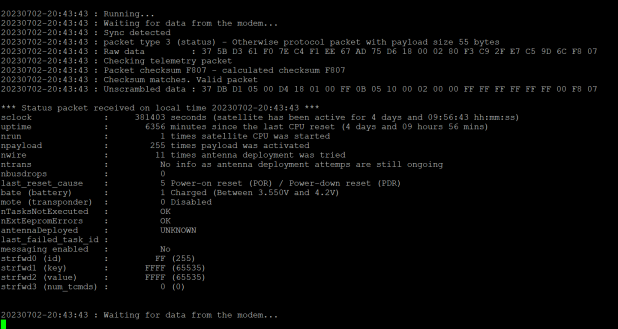And successful decode after a replay.
The data is available in the SatNOGS network
Hm… should ROM-2 and URESAT-1 be followed with the TLE assigned now to MRC-100? They were deployed roughly with the same relative speed from ION SCV-011, so their orbit maybe higher (i.e. 15.117, not 15.132), like MRC-100’s orbit.
That’s a good suggestion, I’ll update the TLE sets of ROM-2 and URESAT-1 in the next hour.
Thanks!
Btw the MRC-100 TLE is still very good! Now i started to see some tiny offset at the center of the waterfall (just a khz or even smaller), see e.g.: SatNOGS Network - Observation 7765972. So, some re-fit could then be performed for further fine-tuning (but i suppose this TLE is fine for the next few days as well).
Until now, i did not find any similar TLE in the 2023-084* batch - neither something with a mean motion of ~15.117 nor any satellite that appears nearby.
I did some IKHNOS mappings for all the possible TLEs left to the observation SatNOGS Network - Observation 7769053 where I think the blury 2 signals belong to satellite ISTANBUL…
According to this, can we try the TLE 56952 for ISTANBUL at obsorvations
Baris
OH2UDS/TA7W
@oh2uds Object 56952 is not ISTANBUL, the TLE may fit the signal but the object that describes was visible before Istanbul deployment.
I don’t think it is right to bind ISTANBUL with a wrong object because it may be separated really quickly. My suggestion is to generate/fit a TLE set on this observation and add it. I’ll do that tomorrow if there isn’t any TLE from space-track.org. However I would be more confident if we can find some more good observations of Istanbul to make sure that what we see in this waterfall is indeed Istanbul, because fitting TLE on the wrong signal could cause issues.
URESAT-1 was received with the help of radiotelescope in California, USA, according to this entry on twitter https://twitter.com/ea4gqs/status/1673772018074779648?s=20
It seems a failure with antenna deployment. AMSAT-EA team is analyzing the 50 baud FSK data collected.
73, Rafael
EA4BPN
Thanks Fredy, I believe these might be useful as well
https://network.satnogs.org/observations/7769106/
https://network.satnogs.org/observations/7769107/
Baris
OH2UDS/TA7W
That’s indeed impressive, I would say that this is probably the best calculation/estimation I’ve ever done. ![]()
So, it seems that MRC-100 is pretty stable.
By the way I expect the next days space-track.org to publish TLE, I’m sure the delay is a result of the recent multi-satellites launches with small satellites that makes it difficult to track and identify.
Now there is a slight indication that MRC-100 is started to speed up with respect to this TLE: SatNOGS Network - Observation 7792637 (so, the mean motion is either slightly underestimated now or we started to see the orbital decay).
Yes, there is no new satellites in the list (at least, what is fetched by gpredict) but let’s hope we will have something soon ![]()
For SpeiSat now is very well suited object #56961 (2023-084-AF).
TLE:
SPEISAT
1 56961U 23084AF 23182.58484223 .00009948 00000-0 55326-3 0 9990
2 56961 97.5126 298.9202 0014989 148.4795 211.7337 15.13775496 2835
Noted!
Noted! Unfortunately I’m not able to create any TLE until tomorrow, but if anyone else can I’ll be glad to add them in DB.
Thanks for the update on Speisat @EU1SAT, while it may currently fit object 56961, I’ll avoid to use it in DB as NORAD ID to follow for this satellite, as we know for sure that this isn’t SPEISAT.
However it is a good pointer/estimation for generating new TLE set. ![]()
Is there any update on URESAT-1 status?
I’ve just seen that in space-strack.org there is identification of object 56958 as “SPEI SATELLES”, wondering if this supposed to be Speisat, if yes there is a good chance this be a mis-identification… I’ll check when I find some time.
No news nor update status unfortunately. I have asked to the URESAT-1 team and waiting for a reply to know if there is any progress…
This a video of AlbaPod (AlbaOrbital) pocketcube satellites deployments. Take a look how close were ROM-2 and URESAT-1 short after deploy.
73, Rafael
MRC-100 TLE based on the following obs
MRC-100
1 99182U 23183.64593750 .00000000 00000-0 00000-0 0 08
2 99182 97.5127 299.5258 0014137 140.8398 162.3807 15.11775597 06
FYI
AMSAT-EA
Jul 2, 2023, 22:56
for contact@amsat-ea.org
Hello everyone,
We inform you that it has been possible to decode state telemetry from URESAT Antonio de Nebrija using the IQ recording made by EA4GPZ with the ATA radio telescope in California (pass at 22:03 UTC on June 26). This recording was made using two different antennas and with two polarizations, which has made it possible to compensate for the fading of one signal with another, as can be seen in the image. The decoding of the status packet shows that the satellite is in good condition, operating normally and that the battery is at a good charge level. The decoding of this status packet confirms what was suspected from the signal level, that the antennas are not deployed (status unknown). This state indicates that the test switch is not open. The telemetry indicates that 11 opening attempts have been made, the first 10 on the first day after the satellite was ejected and the last one after 3 days. The satellite will try to deploy every 3 days until otherwise indicated by remote control. Even in the event that it does not work, it is expected that the thread that holds the antennas will come loose by itself at some point due to the environmental conditions of space.
